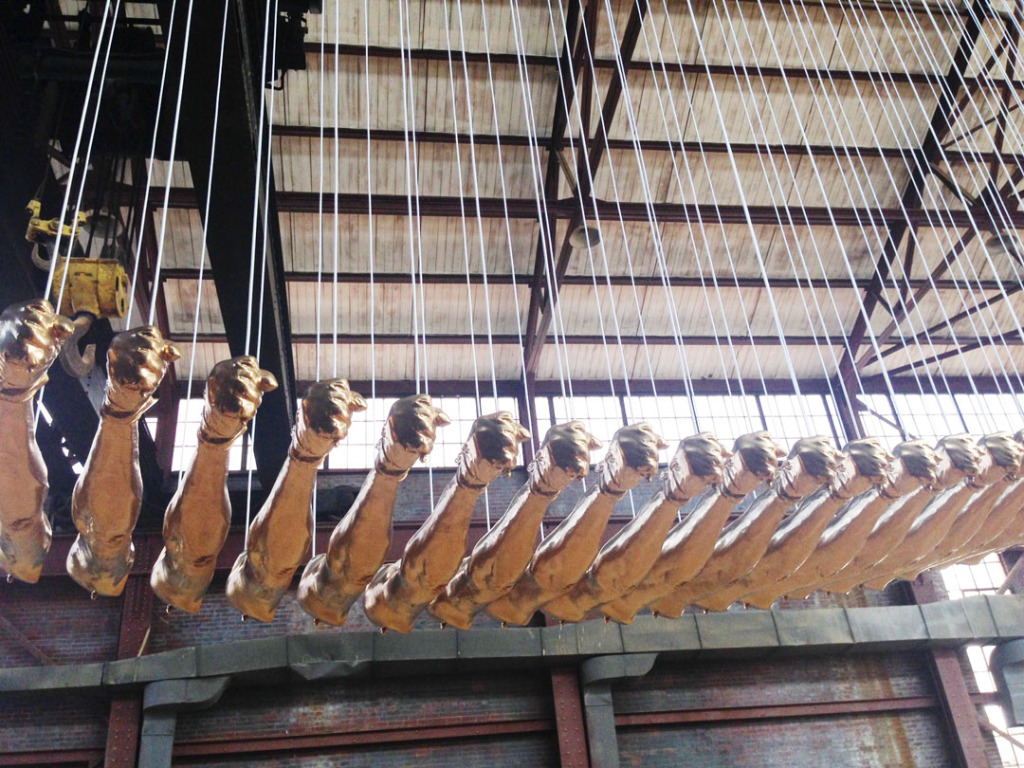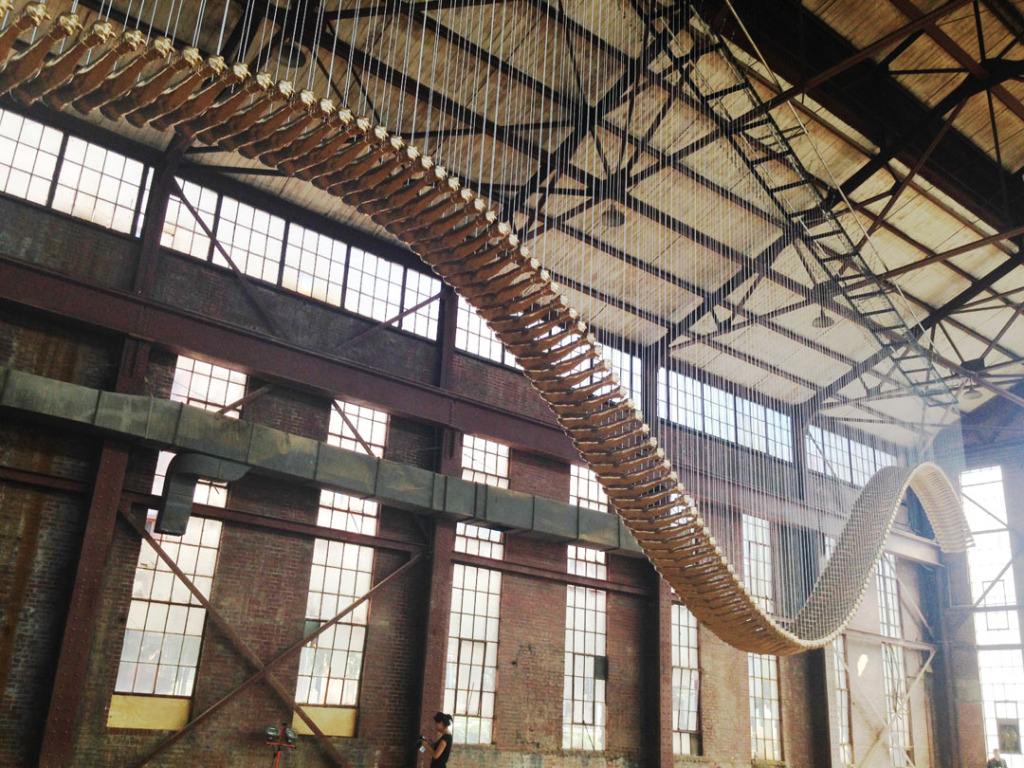
Glenn Kaino, curated by Shamim M. Momin, Bridge (Detail), 2014 Washington DC, The 5×5 Project, Photograph by Katy Hamer
The 5×5 Project was first set in motion by the DC Commission on the Arts and Humanities (DCCAH) in 2012. For 2014, they held an open call and the curators selected include Lance Fung, Shamim M. Momin, Stephanie Sherman, Justine Topfer and A.M. Weaver. Each curator brings his or her own aesthetic interests to Washington, DC allowing for a diverse range of artistic approach and choice of project location. What is Public Art? According to Wikipedia and a post dated March 2013,
“Public art is art in any media that has been planned and executed with the intention of being staged in the physical public domain, usually outside and accessible to all.”
This being said, the definition can be loosely translated and art not necessarily intended for the public domain might fall under the umbrella of this category once exhibited in a the public realm. If focused on the discovering work based on the above definition of Public Art, The 5×5 Project can be somewhat problematic, however successful in how it opens the door to art education in a variety of ways. There are 25 artworks installed around the city in previously unused interior and exterior spaces.
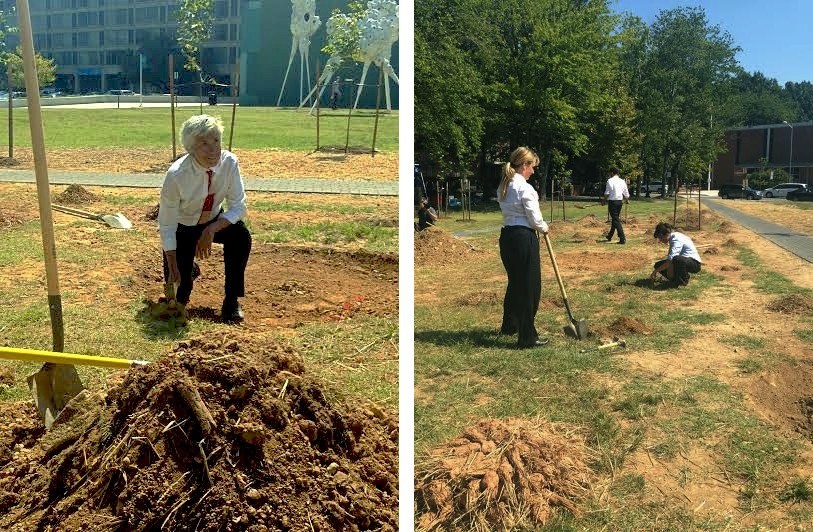
Eliza and Nora Naranjo-Morse, Digging (performance view), Curated by Lance Fung, Washington DC, The 5×5 Project, Photograph/s by Katy Hamer
Unlike some of the curators, Chief Curator of Fung Collaboratives, Lance Fung decided to put all five of his artists in one location. His curated project titled Nonuments (990 4th St, SW), is in a park centrally located in the city. The artists he selected engage the public with art focusing on (per the press release) “the environment, the fight against human trafficking, the positive and negative challenges of neighborhood development and immigration.” This was evident in all of the featured projects but most successful in Digging (2014) a community/land/labor process based work where volunteers and the artists, Eliza and Nora Naranjo-Morse (a mother daughter duo), will be digging and working the land. For every occurrence they will wear a different uniform, including convict, white-collar, doctor scrubs and traditional garb from the Tewa pueblo in New Mexico, commenting on the situations often faced by day laborers. The work is a political performance that is intended for the public sphere.
Shamim M. Momin is a curator and the Director of Los Angeles Nomadic Division (LAND) an organization focusing on site-specific installations inside and outside of L.A. Participating in The 5×5 Project with an exhibition titled Alter/Abolish/Address, she brought together artists including Diana Al-Hadid, Dan Colen, Brendan Fowler, Glenn Kaino, and Marianne Vitale. These works -arguably made by the most well-known of the artists in The 5×5 Project- felt a bit less like what one might assume to be ‘public art’ and rather contemporary art within the public sphere. Such is the case with an amazing and ambitious sculptural installation titled Bridge (2014) by Glenn Kaino. A smaller incarnation of which was installed at The Studio Museum of Harlem in New York (March-June, 2014). Filling the interior of a vast warehouse for this particular install (200 Tingey St, SE), the artist chose to reflect upon the location of the building. Bridge is a work that addresses a particular gesture made by Tommie Smith in the 1968 Summer Olympics in Mexico City, aligning him in solidarity and support of the Black Power movement. The gesture, a clenched and raised fist, resulted in the gold metal winner of the 200-meter race being suspended from the U.S. team and banned from the Olympic Village. Kaino took a cast of Smith’s arm resulting in a fiberglass form, painted gold. There are 200 hundred gold arms forming an arch, snake, or curved spine stretching across the expansive diameter of this vast interior. The piece is striking and the building is open to the public for viewing throughout the duration of the exhibition.
Another of Momin’s artists is Dan Colen who made two site-specific artworks, one in particular that is the most elusive and difficult to view in 5×5. Working with the natural elements and structural aesthetics of an urban environment, Colen constructed a highly technical yet visually simple work, Hat (2014). It consists of a wool fedora wired and mechanized that appears to “float” underneath an overpass. The work is based on a film scene by Joel and Ethan Coen in their 1990 film, Miller’s Crossing and references (from the press release) “a dead man’s hat [that] blows away in the woods, conveying a sense of poetic despair and hope abandoned.” The obscurity of Hat (it will only be on view each Wednesday at noon) allows for the piece to become a destination in a very different way than the other artworks. Colen’s Hat is an intended action. Visually it functions in a similar -yet completely different way in it’s repetitive, even if seldom, operation- to the gravitational happenstance of an actual hat that should blow off one’s head and be taken by a breeze. Colen’s piece is participating in a celluloid inquiry yet assuming the physical form somewhere between sculpture and performance, the movement appears to go forward and is then rewound, one frame at a time.
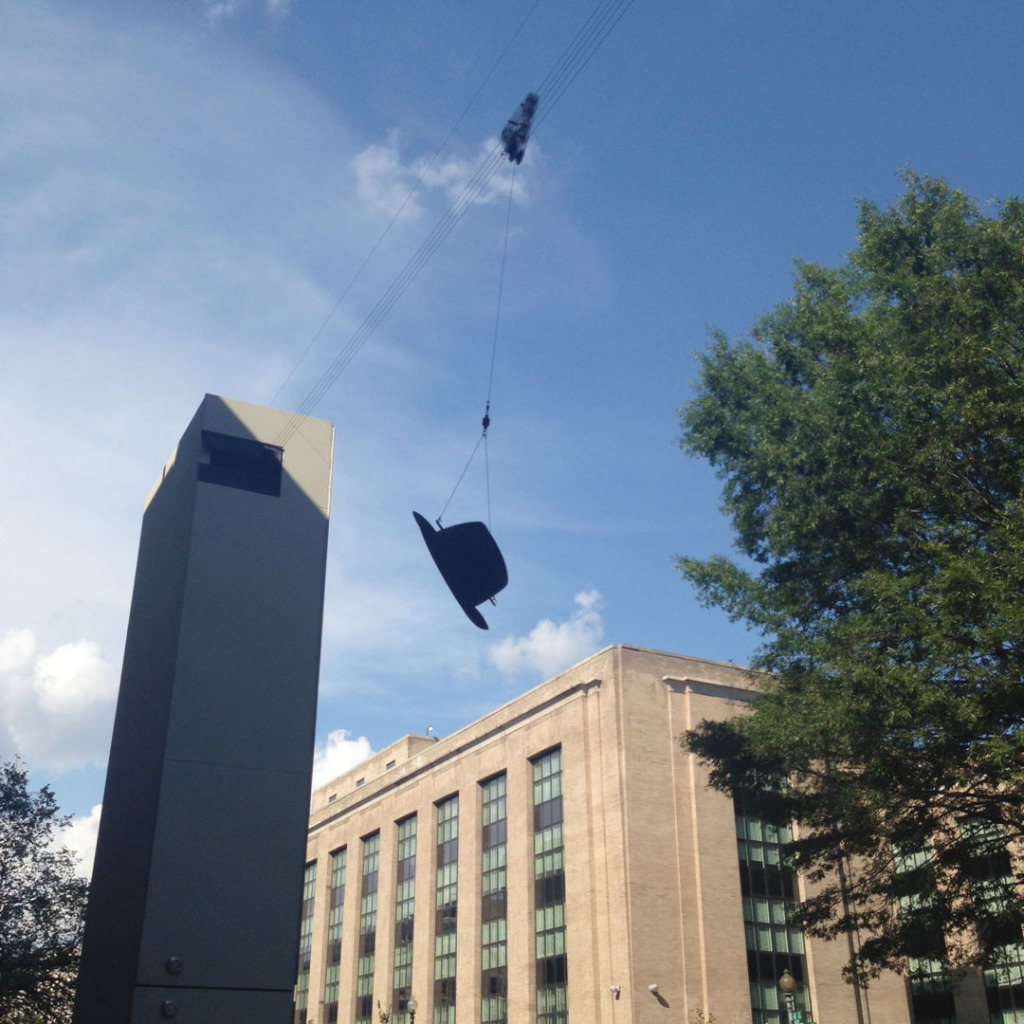
Dan Colen, Curated by Shamim M. Momin, Hat, 2014, Site-specific installation, Washington DC, The 5×5 Project, Photograph by Katy Hamer
Lastly, the final curator I will mention is Australian born Justine Topfer whose project (home)land, is one of the strongest. She collaborated with an international roster of artists from countries such as Germany, Japan, Australia, Iran and Canada. In particular, artist Sanaz Mazinani, made a series of vinyl printed wallpapers, U.S.A.I.R.A.N. (2014), that cover the façade of a former library not far from the bus station. Each print is elaborate in it’s digitally collaged layering of familiar objects and icons of Washington DC. Born in Tehran in 1978 (one year before the Iranian Revolution), the artist immigrated with her family to Canada when 11 years old and is now based in the US. Her work is an illusion of sorts, seemingly mosaic or stained glass, they each mimic what one might associate with traditional patterns of the Middle East. The piece, especially being that it is shown in the nation’s capital, could not be more timely in it’s visual communication between the US and Iran. It’s almost as if the artist has created a selfie, an intimate exploration without ever showing us her face.

Sanaz Mazinani, curated by Justine Topfer, U.S.A.I.R.A.N. (Detail), 2014, Printed vinyl, Washington DC, The 5×5 Project, Photograph by Katy Hamer
The 5×5 Project succeeds in bringing contemporary works to the public sphere. In doing so, people who may not be accustomed to looking at art will have the opportunity and seasoned art appreciators will also be satisfied if even in the treasure hunt which at times is required. In the future, it might be interesting to see how the curators would interpret one theme, possibly resulting in more of a cohesive experience overall. Several upcoming events and performances are planned. Please visit The 5×5 Project website for more information.
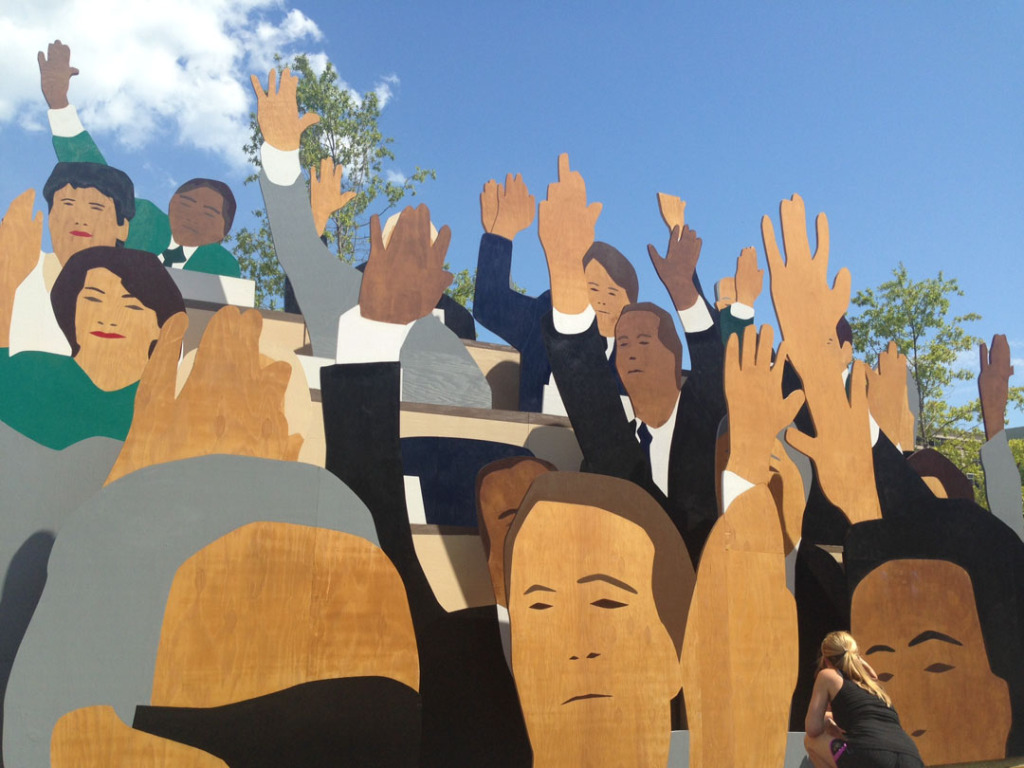
Kota Ezawa, Curated by Justine Topfer, Hand Vote, (Detail, 2014), Washinton DC, The 5×5 Project, Photograph by Katy Hamer
More soon!
xo

